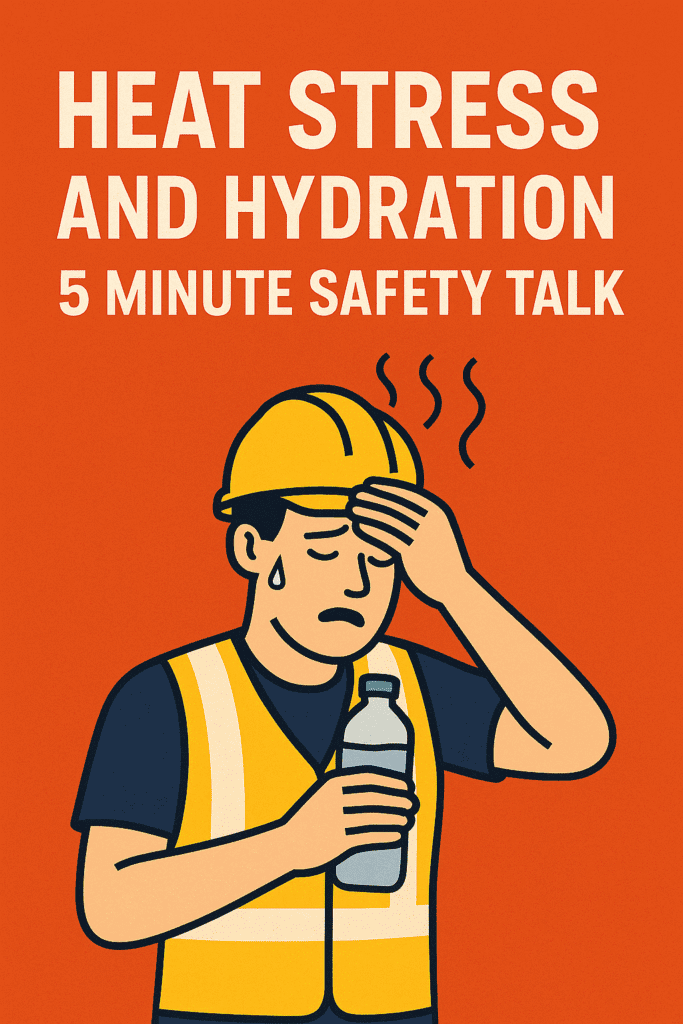
Heat Stress and Hydration 5 Minute Safety Talk
Good Morning Team,
Let’s take a few minutes today to talk about something that becomes especially important during hot weather—or anytime we’re working in warm conditions: Heat Stress and Hydration.
Whether we’re working outdoors in the sun or indoors near machinery, heat can sneak up on us and become dangerous fast. Add in dehydration, and you’ve got a serious risk to your health and safety.
So today, we’re going to break down what heat stress is, how to spot it early, and what we can do to prevent it—especially by staying hydrated.
What is Heat Stress?
Heat stress happens when your body can’t cool itself fast enough. As your core temperature rises, it can lead to conditions like:
- Heat rash
- Heat cramps
- Heat exhaustion
- Heat stroke – A medical emergency
Common Causes of Heat Stress
- Working in high temperatures, humidity, or direct sunlight
- Wearing heavy PPE or protective clothing
- Performing physically demanding tasks
- Not drinking enough water
- Poor ventilation or confined spaces
Early Warning Signs to Watch For
Be on the lookout for:
- Heavy sweating
- Headache
- Dizziness or fainting
- Muscle cramps
- Nausea or vomiting
- Fatigue or weakness
- Confusion or irritability
- Dry, hot skin in the case of heat stroke
If any of these symptoms occur—stop work immediately and get help.
The Role of Hydration
Staying hydrated is your first defense against heat stress.
How Much Water Should You Drink?
- At least 1 cup (250 ml) every 15–20 minutes
- Don’t wait until you’re thirsty—by then, you’re already dehydrated
Avoid These Drinks:
- Energy drinks
- Caffeinated sodas
- Coffee
- Alcohol (even the night before work)
They dehydrate you and make things worse.
Tips to Prevent Heat Stress
- Start hydrated – Drink water before starting work
- Take breaks in shaded or cool areas
- Wear lightweight, breathable clothing
- Use cooling towels or fans
- Use a buddy system – Watch out for signs in each other
- Acclimatize new workers gradually to hot conditions
What to Do in Case of Heat-Related Illness
For Heat Exhaustion:
- Move the person to a cooler place
- Remove outer clothing
- Give cool water slowly
- Apply cool compresses
- Seek medical help if symptoms don’t improve
For Heat Stroke (EMERGENCY):
- Call emergency services immediately
- Cool the person rapidly (cold water, fan, wet cloths)
- Do NOT give fluids if they’re unconscious or confused
Real-World Example
On a summer day, a worker on a construction site collapsed from heat stroke. He had been pushing through the work, wearing a heavy harness, and hadn’t had water in over 2 hours. His coworkers acted fast—they moved him into the shade, called for help, and applied cold packs. He survived, but it could have been fatal.
Moral? Drink water. Take breaks. Don’t push past your limits.
Summary – What You Should Now Know
- Heat stress can creep in quickly—stay alert
- Drink water regularly—don’t wait for thirst
- Watch for signs of heat illness in yourself and others
- Take breaks, dress smart, and use a buddy system
- Know when to call for help
Noise Hazards and Hearing Protection 5 Minute Safety Talk
First Aid Awareness 5 Minute Safety Talk
Emergency Evacuation Procedures 5 Minute Safety Talk
Ladder Safety 5 Minute Safety Talk
Manual Handling 5 Minute Safety Talk
5 Unique FAQs
Q1: How much water should I drink during a full work shift?
You should aim for 1 liter per hour, depending on heat and activity.
Q2: Is it okay to drink energy drinks while working in heat?
No. They contain caffeine and sugar, which dehydrate your body further.
Q3: What’s the difference between heat exhaustion and heat stroke?
Heat stroke is more severe—it involves confusion, no sweating, and can be life-threatening. Heat exhaustion includes sweating and fatigue.
Q4: How can I cool down quickly on-site?
Move to shade, use a wet cloth, drink cool water, and remove extra clothing or PPE.
Q5: What’s the best way to remind workers to hydrate?
Use water stations, reminder signs, or assign a hydration buddy on shift.